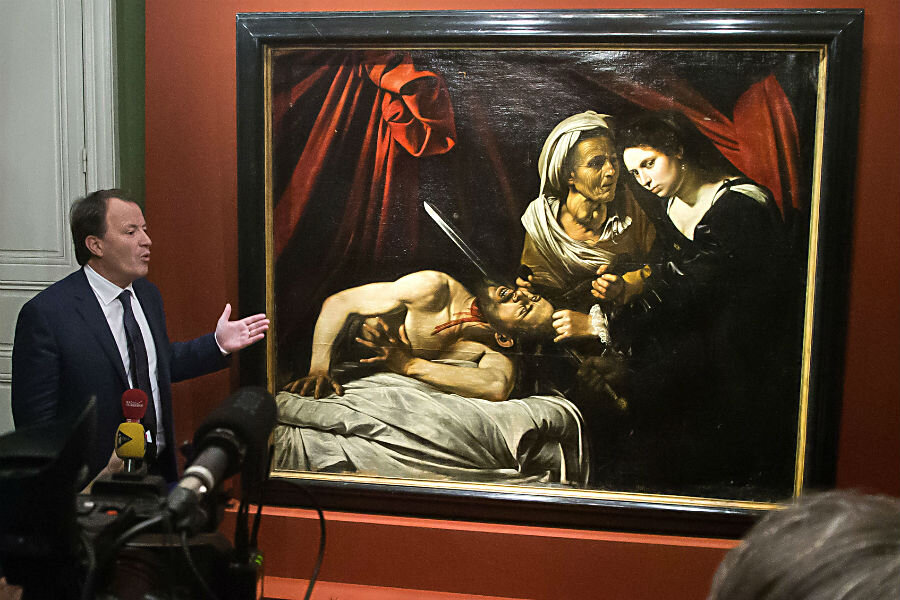$135 million painting found in French attic: A Caravaggio?
| Paris
A 400-year-old picture that might have been painted by Italian master Michelangelo Merisi da Caravaggio has been found in an attic in southern France.
Eric Turquin, the French expert who retrieved the painting two years ago, said it is in an exceptional state of conservation and estimated its value at 120 million euros (about $135 million), even though he acknowledged experts disagree about its authenticity.
Called "Judith Beheading Holofernes," it depicts the biblical heroine Judith beheading an Assyrian general. It is thought to have been painted in Rome around 1604-05.
Turquin told a news conference on Tuesday that there "will never be a consensus" about the artist.
Two Caravaggio experts he consulted with attributed the painting to Louis Finson, a Flemish painter and art dealer who was familiar with Caravaggio, Turquin said. Finson possessed a number of works from the Italian master and made copies of his pictures.
"But the third expert I met told me that it was not only a Caravaggio, but also a masterpiece," Turquin said. "'Judith Beheading Holofernes' must be considered the most important painting, by far, to have emerged in the last 20 years by one of the great masters."
The picture has been awarded "National Treasure" status by French authorities, meaning that it can't be exported for 30 months, leaving the national museums enough time for its acquisition.
While the art work has yet to be authenticated, France's Culture Ministry justified its decision to ban the export of the painting because it "deserves to be kept on (French) territory as a very important landmark of Caravaggism."
Bruno Arciprete, the Naples-based expert who restored Caravaggio's "Flagellation of the Lord" and "Seven Works of Mercy," said the painting could well be a Caravaggio but that further studies are needed.
"It has interesting characteristics that can be attributed to Caravaggio," he said in a phone interview.
Arciprete said he saw the work a few months ago in Paris and came away with a "very good impression."
"What is required is more scientific research, and then studies by art historians," to specifically look at the technique, pigments, the type of canvas and its preparation to see if it corresponds to those used by Caravaggio, he said.
However Richard E. Spear, a scholar of Italian Baroque art who is an expert on Caravaggio, said he was "highly dubious" that the Italian master actually painted the art work.
Spear, who has only seen photos of the painting, told the AP that he wasn't convinced by the handling of the brushwork and that some anatomical details of the characters raised questions.
"Altogether, the picture looks rather coarse and heavy to me," he said.
The owners of the house in Toulouse discovered the painting, which had been partially damaged by water, when they went to the attic to fix a leak.
Turquin kept the picture away from the public eye for two years, cleaning it and submitting it to a deep examination that included infra-red reflectography and X-rays. Because of the painting's large size, some of the checks were made at a veterinary school.
"In between a horse and a cow, the radiologist was a bit surprised," Turquin joked. "Then she told us we brought her a stolen picture, because she thought it was actually the contemporary copy from Finson."
That copy is on display in Naples and belongs to an Italian bank.
According to Turquin's team of experts, the two paintings were recorded in Finson's will made in Amsterdam in 1617. Then the original disappeared.
"It's a painting of a composition that we know of from the other versions, and whether there's a Caravaggio behind it we still have not found, or is this an invention by Finson? That, we don't know for sure," Spear added.
Turquin, on the other hand, says he doesn't need further expertise.
"Everybody agrees on the fact that it's one of the most important masterpieces from the 17th century to have emerged over the past 30 years," said Turquin, who has been watching over the painting. Since its delivery in Paris, he has been sleeping with the painting in his bedroom, as a security measure.
In the early 1990s, another Caravaggio was found, The Christian Science Monitor reported:
A sooty, grease-splattered painting that had loomed over the dining room of a monks' residence in Ireland for 60 years had been cleaned, and lo and behold, it turned out to be a missing painting by the influential Baroque artist Michelangelo Merisi da Caravaggio...
For more than 200 years, "The Taking of Christ" has been nowhere to be found. Art sleuths had scratched their heads, baffled by the disappearance of the painting of armored guards lunging at Jesus, who is draped in red and turquoise.
___
Nicole Winfield in Rome contributed to this report.





